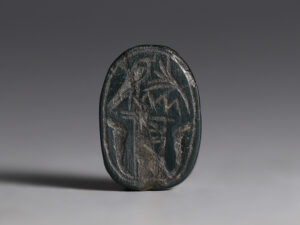The hieroglyphs upon this scarab represent a blessing to the god Amun, invoked by the wearer. It reassures the wearer that Amun-Re is watching over him. Scarabs such as this, asking for protection from a specific god were popular in the late New Kingdom Period and Third Intermediate Period.
The Egyptian god, Amun-Ra, was a highly important deity in the Egyptian pantheon. Originally, he was worshipped as two gods, the creator of the universe, Amun, and the sun-god, Ra. He gains national importance after the defeat of the Hyksos at Thebes in the 16th century and it is from this date we see a combination of the two gods. As his position grew, Amun-Ra’s worship was almost monotheistic in nature, with the other gods considered manifestations of him. So great was his influence that he was identified with the Greek god Zeus from the Ptolemaic period, to form Zeus Ammon. Alexander the Great claimed divine descent as the son of Amun.
 Phoenician-Egyptian Haematite Scarab with Hieroglyphic Inscription
$1,018.26
Phoenician-Egyptian Haematite Scarab with Hieroglyphic Inscription
$1,018.26
 Egyptian Steatite Scarab Dedicated to Amun-Re
$1,086.14
Egyptian Steatite Scarab Dedicated to Amun-Re
$1,086.14
Egyptian Steatite Scarab Amulet with a Blessing to Amun-Ra
$509.13
A glazed steatite Egyptian scarab beetle amulet with incised features to the obverse, forming the clypeus, prothorax and elytra. The reverse features incised hieroglyphs depicting a blessing to the god Amun. From the top of the scarab three symbols are depicted. Firstly, the hieroglyph for ‘venerated’ which is depicted as a backbone with spinal fluid seeping out. It transliterates as ‘ỉmȝḫ’. Secondly is the prominent eye hieroglyph, which is a determinative for motions connected to watching and seeing. In this instance, it refers to the god Amun-Ra watching over the deceased. The final sign is the barque, which is a determinative for the god Amun-Ra. The scarab is pierced longitudinally for suspension.
1 in stock
Additional information
| Weight | 2.6 g |
|---|---|
| Dimensions | 1.7 × 1.2 cm |
| Culture | Ancient Egyptian |
| Material | Steatite |
| Region | North Africa |
| Egyptian mythology | Amun |



















